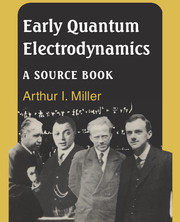Book contents
- Frontmatter
- Contents
- Preface
- Notes to the Preface
- Acknowledgements
- Notes to the Reader
- I Frame-setting essay
- Epilogue
- Notes
- References to the Frame-setting essay
- II Selected papers
- 1 The self-energy of the electron
- 2 Remarks on radiation theory
- 3 Theory of the positron
- 4 Discussion of the infinite distribution of electrons in the theory of the positron
- 5 The self-energy of the electron
- 6 Remarks on the Dirac theory of the positron
- 7 The quantization of the scalar relativistic wave equation
- 8 The electrodynamics of the vacuum based on the quantum theory of the electron
- 9 Theory of the emission of long-wave light quanta
- 10 The universal length appearing in the theory of elementary particles
- 11 The interaction between charged particles and the radiation field
- Index to Frame-setting essay
9 - Theory of the emission of long-wave light quanta
Published online by Cambridge University Press: 05 August 2012
- Frontmatter
- Contents
- Preface
- Notes to the Preface
- Acknowledgements
- Notes to the Reader
- I Frame-setting essay
- Epilogue
- Notes
- References to the Frame-setting essay
- II Selected papers
- 1 The self-energy of the electron
- 2 Remarks on radiation theory
- 3 Theory of the positron
- 4 Discussion of the infinite distribution of electrons in the theory of the positron
- 5 The self-energy of the electron
- 6 Remarks on the Dirac theory of the positron
- 7 The quantization of the scalar relativistic wave equation
- 8 The electrodynamics of the vacuum based on the quantum theory of the electron
- 9 Theory of the emission of long-wave light quanta
- 10 The universal length appearing in the theory of elementary particles
- 11 The interaction between charged particles and the radiation field
- Index to Frame-setting essay
Summary
Nuovo Cimento, 15, 167–88. Presented at the Galvani Bicentenary Congress, Bologna, 18–21 October 1937.
Summary – As is well known, the usual radiation theory yields an infinitely large value (infrared catastrophe) for the cross section dq of a charged particle when it traverses a force field and is deflected at a given angle. For if one prescribes that the energy loss of the particle should lie between E and E + dE, then, according to this theory, for small E one obtains dq = const. dE/E, which, upon integration, diverges logarithmically at the point E = 0. The present paper investigates more precisely what quantum electrodynamics yields for this cross section if a finite extent is ascribed to the charged body. It appears that then the infinity is indeed removed and that the deflections which are considered as nonradiative in the ordinary theory here appear as having a finite, although very small, energy loss. On the other hand, according to the exact theory, the more precise behavior of dq for very small energy losses E depends so strongly on the extension of the charged body, that a direct application of the result to real electrons is not possible. Therefore, one must conclude that the problem in question is related in an essential manner to the still unresolved fundamental difficulties of quantum electrodynamics.
Introduction
One of the well-known difficulties of quantum electrodynamics concerns the infinite self-energy of a charged particle. In addition, as is well known, there is also a divergent result of this theory which concerns the emission of light quanta of very low frequency.
- Type
- Chapter
- Information
- Early Quantum ElectrodynamicsA Sourcebook, pp. 227 - 243Publisher: Cambridge University PressPrint publication year: 1994



